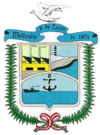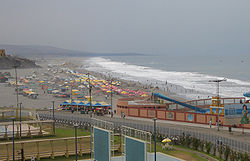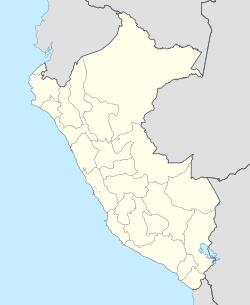- Mollendo
-
Mollendo — Town — View of Mollendo beach 
Coat of armsNickname(s): Puerto Bravo Location of the town of Mollendo in Peru Coordinates: 17°1′23″S 72°0′53″W / 17.02306°S 72.01472°W Country  Peru
PeruRegion Arequipa Region Province Islay District Mollendo District Government - Mayor Miguel Román Valdivia Population - Total 28,953 Time zone PET (UTC-5) - Summer (DST) PET (UTC-5) Website www.munimollendo.gob.pe Mollendo is a town bordering the Pacific Ocean in southern Peru. It is located in the Arequipa Region and is the capital of both the Islay Province and the Mollendo District. Mollendo was the main port in the Peruvian southern coast until Matarani was developed about 50 years ago; the port of Mollendo only serves fishermen for the local economy currently and all the commercial shipping is done through Matarani 12 kilometers north; the old port is in ruins. Mollendo's population more than doubles during the summer, mostly from people from Arequipa. The railroad used to run a passenger train daily, but a good highway connects Mollendo to the Panamerican Highway now and the train now only runs the summer express that goes down from Arequipa on Saturday and returns on Sunday; the beach is the main attraction, even though it is visited by the Humboldt Current that brings cold water from Antarctica.
Mollendo exports wool and has industries producing cement, textiles, canned fish, and cheese. It is also a popular beach resort. The Auxiliary Ship BAP Mollendo (ATC-131) of the Peruvian Navy is named after the town.
Contents
History
The Inca era
In 1134, the inca Mayta Cápac, puts the regions of Arequipa and Moquegua under the control of the Inca empire. Sixty three years later, in 1197 and according to Garcilazo de la Vega, the Inca Cápac Yupanqui, following traditional customs of the Inca Empire, selected four generals from his major staff and entrusted them the command of approximately twenty thousand soldiers (or Tuqui Titos) for the coast region conquest project.
Cápac Yupanqui's son, Sinchi Rocca, conquered all of Arequipa and Moquegua coast area. From this avent and ahead, Tambo is a main protagonist into the region history, due their geographical position and serving as weapons and food supply depot. Inca Yáhuar Huácac, successor of Inca Cápac Yupanqui, established his supply depots and headquarters in this valley, to march into Atacama (north Chilean region) direction to expand the territory of the Inca Empire.
First inhabitants
After Tiahuanaco's culture decadency and during the Inca era, Peruvian south coast were occupied for several tribes:
- The "Tampus" stationed into today Tambo region.
- The "Chullis" corresponding to Chule zone.
- The "Changos" located between the Aranta and Islay zones.
The river basin formed by the Tambo river, probably conquest and occupied by external forces during several periods, generate a population with local and heterogeneous customs, leaving several vestiges about their civilization, suddenly attached to the remaining mixed etymology name from several languages such as Quechua, Cocachacra, Challascapi, etc. Another external influences were the Kauiqui and Puquina with characteristic suffixes such as ando, endo, indo. Some examples are: Cachendo, Mollendo, Huarindo, Catarindo, etc.
A large population were located along the valley and nearing hills, serving it from subterranean waters. Influence of the sea was decisive on the valley and coast inhabitants were the mama coccha (the sea creator) provide them with fish and sea fruits.
War of the Pacific
During the War of the Pacific Mollendo was invaded by Chilean forces under the command of Colonel Orozimbo Barbosa. The main idea of this army (transported by the Chilean Navy) was to wreak havoc on Southern Peru, so as to force the process of negotiations for peace between Peru and Chile. The invasion forces consisted of the 3rd Chilean Line Infantry Regiment, The Chilean Marines, One brigade of Chilean Sappers, and 30 Horse Cavalry. The defenses of Mollendo consisted of two small forts with no cannon ( which were days earlier transported to Arequipa) defended by 100 soldiers. The first to disembark were the Chilean Marines, who took the town without a struggle. The rest (Main Body) of the expedition landed on or near Islay, without opposition. On March 9, 1880, the Main Body of the expedition entered Mollendo. Colonel Barbosa with 500 soldiers left Mollendo towards Mejia in search of the defenders, leaving the 3rd Chilean Line Infantry in charge of the town, looting of homes quickly began. Colonel Barbosa arrived in Mejia, destroying the locomotives and railtracks to prevent reinforcements arriving from Arequipa via rail. Colonel Barbosa surprised the defenders at Ensenada, taking 20 prisoners. Upon his return to Mollendo, he learned of the sacking of the town, punishing some members of his command. This resulted in some desertions.
Airport
The town of Mollendo is serviced by the small civilian Mollendo Airport ICAO Code (SPDO)
Railway
The town is served by the standard gauge Southern Railway of Peru, which connects with Cuzco and Puno.
Notable people from Mollendo
See also
- Railway stations in Peru
References
External links
- Sobre Mollendo
- Mollendo Airport
- (Spanish) War in the Pacific Mollendo Invaded
- MSN Map
Coordinates: 17°01′00″S 72°01′00″W / 17.0166667°S 72.0166667°W
Categories:- Populated places in the Arequipa Region
Wikimedia Foundation. 2010.


